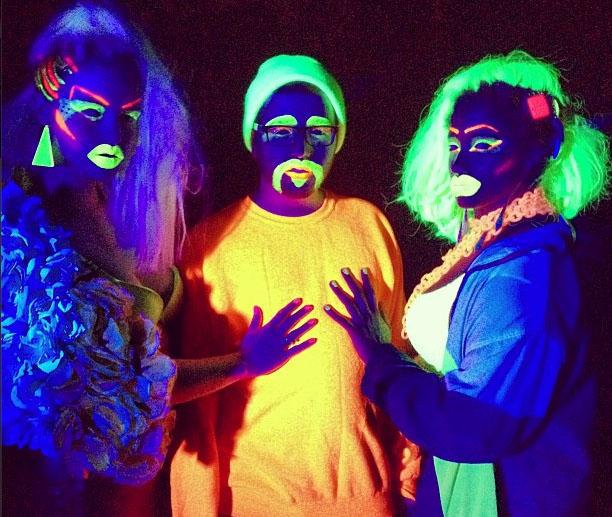Theatre sophomore Kristin Wallace, graphic design senior Hannah Joffray and mass communication senior Dustin Farris are the trio that makes up a Loyola band named Chilldren.
In 2010, these three non-musical freshmen decided to create a rap group out of boredom. Fast-forwarding three years, Chilldren posted their “#SWEAT” video on YouTube on June 1, 2013.
On Nov. 21, 2013, buzz swirled around Major Lazer, an electronic DJ project created by Diplo, when he posted a similar YouTube video entitled “Sweat.”
Chilldren started off as a “fake band,” music industry senior Adam Stewart said.
“They are weirdos that made a fake Facebook group saying they were a band. Even though they didn’t have any music or any idea how to even make songs or anything,” Stewart said.
However, Stewart said he saw enough potential to approach them. He advised them to use their “weirdness” to actually produce music.
Farris said Chilldren has evolved in to its own genre of “party music.” Chilldren began making the right connections when they were given the opportunity to film a music video.
“Our friends and local artists at Everything Collective directed the video and we filmed it at City Park in the middle of the night. We filmed it all in one night with a $0 budget. It was truly a DIY project,” Farris said.
Joffray remembers the “wigs, glitter, and weird costumes scattered everywhere” as they got dressed in a blue bus.
Wallace said their only request was to incorporate Furbies in the video. She described themselves as “sexy glow in the dark forest nymphs with Furbies.”
Farris said it was fun being “trudged through mud” while filming certain shots. Months later, Chilldren was surprised to find Major Lazer and director Ryan Staake’s “Sweat” music video.
“Our in-house drama detective K. Wallace called me at like four in the morning all like ‘Oh my God,'” Stewart said.
Farris said Diplo has many connections to New Orleans, and has worked with local New Orleans bounce artists like Nicky Da B, who Chilldren has done shows with. They also opened for Riff Raff, who is signed to Diplo’s label. Farris said he believes it is possible that Diplo could have heard of their band or seen their work before.
“We’re the first to admit that the black-light/glow concept is not something that we created, so it’s not even that we feel that our concept was stolen. Although it was really fishy that their song was also called ‘Sweat’,” Farris said.
Kevin Kusatsu of Diplo Management, released a statement on Nov. 25, addressing that Major Lazer finished making his “Sweat” song before Chilldren dropped their video.
“The Major Lazer album ‘Free The Universe’ was released April 16, 2013. The song ‘Sweat’ is featured on that as well as 13 others,” Kusatsu said. “This particular song was titled and finished in the latter half of 2012.”
Loyola instructor Scott Sternberg reviewed Chilldren’s case in Farris’s copyright class. Sternberg said his class thought Chilldren “got ripped off.” He admits that the videos are “certainly similar,” but says the songs aren’t. He said it’s very difficult to pinpoint whether Major Lazer’s video violates copyright laws.
“It would be up to a judge to determine whether the two videos were substantially similar, and whether Major Lazer had access and ability to infringe on the Chilldren’s copyrighted material,” Sternberg said.
Sternberg said that copyright doesn’t protect the idea of “glow-in-the-dark stuff” in videos. However, copyright does protect the video itself, dance moves, and song.
“Think about the first person who used a fish-eye on a photo lens or slowed down the timing of a rap record to make it ‘chopped and screwed,'” Sternberg said. “Those ‘ideas’ aren’t copyrightable, but the specific photos, video or song recordings are.”
Chilldren opted to push the issue on social media, and they received the publicity they needed when a community Buzzfeed post written by mass communication junior Hannah Gomez Farias was published that described the videos’ similarities as far from coincidental.
“I really appreciate that the girl who made it did it in a traditional Buzzfeed style with the side by side comparisons and such. It really revealed the similarities, maybe more than I realized,” Wallace said.
Major Lazer’s video producer Ryan Staake said he tried to resolve the issue with Chilldren, but it “yielded little positive outcomes.” He stressed that he did not steal anyone’s video idea, regardless of what the Buzzfeed article implied.
“Blacklight videos are inherently very similar. I proved that I didn’t steal from Chilldren, any further claims are paranoid,” Staake said.
Staake publicly addressed this issue on
Nov. 25 and showed that he emailed the “Sweat” video idea to Major Lazer’s management on March 3. He said that was four months before Chilldren’s video was released.
“I don’t know what sort of deranged idea-thief would steal from a video with the exact same name as the video he’s stealing for. That’s like stealing your neighbor’s car and parking it in your driveway,” Staake said.
Although, Kusatsu admits the similarities sparked many questions, he says he and Diplo didn’t question Staake’s intention.
“We’ve worked with Ryan Staake in several capacities over the last six years as well as other clients under the management company. At no point have we ever needed to question or doubt his creative genesis,” Kusatsu said.
A feud between Chilldren, Stewart, and Staake arose via Twitter, but Joffray said eventually they all reached an agreement to drop the incident.
“I respected him after he had explained himself the first time but when he decided to pick at the scab, it was too much. It was honestly not a move of a professional, which he constantly assured that he was,” Joffray said.
Wallace says that maybe one day these rivals will be able to mend their relationship and become friends. She admits both parties could’ve handled the situation better.
Diana Mirfiq can be reached at dnmirfiq@loyno.edu






